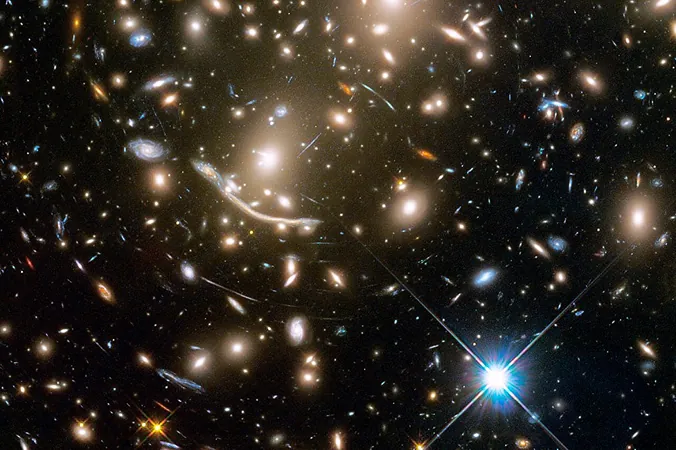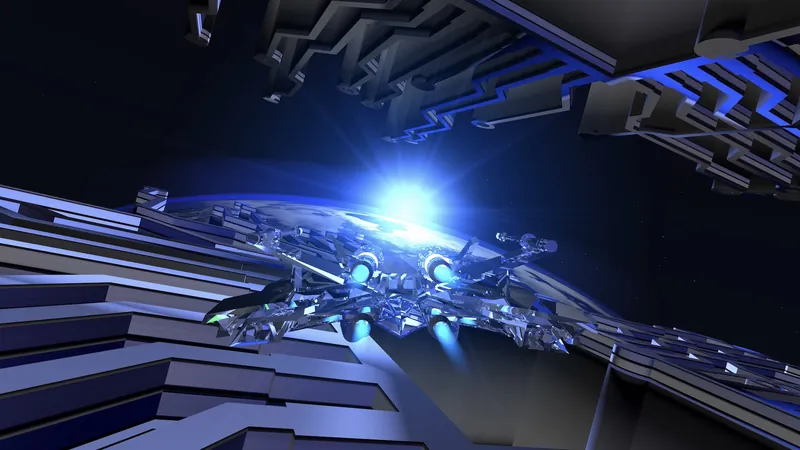
Major Breakthrough in Astronomy: 44 Ancient Stars Captured Thanks to Gravitational Lensing!
2025-01-09
Author: Jacob
Major Breakthrough in Astronomy: 44 Ancient Stars Captured Thanks to Gravitational Lensing!
In a landmark achievement for astronomers, a team has successfully imaged an astounding number of ancient stars, unveiling insights from an epoch when the universe was only half its current age.
Utilizing the incredible capabilities of NASA's James Webb Space Telescope (JWST), the scientists identified 44 stars in the Dragon Arc galaxy, situated a staggering 6.5 billion light years away from the Milky Way. The remarkable discovery hinged on the principles of gravitational lensing, a phenomenon predicted by Einstein's theory of general relativity. This cosmic lensing provides a means to probe interstellar realms previously obscured from our view.
Jacqueline McCleary, an assistant professor of physics at Northeastern University, emphasized the significance of this discovery: “This is a window to observe the processes of star formation during a much earlier period in the universe’s history. It’s akin to a time machine, allowing us to witness what individual stars looked like billions of years ago.”
So, what exactly is gravitational lensing, and how did it facilitate this extraordinary observation?
Gravitational lensing occurs when massive objects, such as galaxies and galaxy clusters, warp the space-time around them, bending the paths of light traveling from more distant objects. McCleary illustrates this with the analogy of a stretched rubber sheet: placing a heavy object on the sheet creates a dip that deflects lighter objects (like marbles) rolling nearby. Similarly, massive galaxies create gravitational wells that affect light rays from distant stars.
Observing individual stars beyond our local cosmic neighborhood is extremely challenging. While astronomers can scrutinize individual stars in the Milky Way and its close neighbors, stars located in distant galaxies remain nearly impossible to identify clearly. In this case, however, the astronomers were able to exploit the gravitational distortion caused by the immense galaxy cluster Abell 370, which acted as a giant magnifying glass, revealing the light from the 44 stars in the Dragon Arc galaxy.
Adding an extra layer to the discovery was an additional effect known as microlensing. As smaller, free-floating stars traversed the path of the light from the distant stars, they inadvertently amplified the light even further, allowing for greater discernibility of individual stars on the periphery of the galaxy.
This unique double lensing scenario was previously utilized in astronomical studies but had only yielded images capturing sporadic new stars. The recent capture of 44 stars marks a significant leap forward in our understanding of star formation in ancient celestial objects.
What excites McCleary and her colleagues is not just the use of cutting-edge technology to capture these images but also the potential it creates for future explorations. “This opens up new pathways for astrophysicists to delve even deeper into the early universe,” she states. The discovery, albeit serendipitous, showcases the vast potential of the JWST in revealing hidden treasures of the cosmos.
It is anticipated that this finding will inspire a collaborative effort among scientists, who will comb through existing JWST data in hopes of uncovering even more ancient stars. McCleary foresees that the number of newly identified stars could escalate from 44 in one cluster to potentially hundreds as researchers explore multiple galaxy clusters.
The implications of this discovery could reshape our understanding of the universe's history and its star formation processes. Stay tuned for what could be the dawn of a new era in astronomical exploration!









 Brasil (PT)
Brasil (PT)
 Canada (EN)
Canada (EN)
 Chile (ES)
Chile (ES)
 Česko (CS)
Česko (CS)
 대한민국 (KO)
대한민국 (KO)
 España (ES)
España (ES)
 France (FR)
France (FR)
 Hong Kong (EN)
Hong Kong (EN)
 Italia (IT)
Italia (IT)
 日本 (JA)
日本 (JA)
 Magyarország (HU)
Magyarország (HU)
 Norge (NO)
Norge (NO)
 Polska (PL)
Polska (PL)
 Schweiz (DE)
Schweiz (DE)
 Singapore (EN)
Singapore (EN)
 Sverige (SV)
Sverige (SV)
 Suomi (FI)
Suomi (FI)
 Türkiye (TR)
Türkiye (TR)
 الإمارات العربية المتحدة (AR)
الإمارات العربية المتحدة (AR)